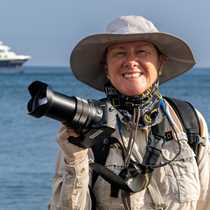Cerro Dragon & Eden Islet
We woke up in yet another new location: the northeastern-most corner of Santa Cruz Island. The sea around us was flat calm, so every ripple caught the eye. During breakfast something large made a huge splash; never found out what. The mystery of the ocean inhabitants keeps us alert and attentive, wanting to know more, wanting to see more.
But before entering the water, we visited land, an area known as Cerro Dragon. This place is known for the large, yellow-orange land iguanas endemic to Galápagos. This rainy season has been heavier than normal, and the vegetation is lush and tall, making finding ground-dwelling reptiles a tad tricky, or so we thought. Fortunately we had some sharp-eyed hikers along and had some exceptional views of these endangered and vulnerable iguanas hiding under shrubs and in the thigh-high grass. Twice my group found them actually in the trail – understandably the easiest path to follow from A to B! The endemic Gossypium darwini, or Darwin’s cotton, had blooms galore; common stilts and pintail ducks were found in the lagoon; the Palo Santo trees smelled delicious, as they should, also being called incense trees.
By the time we made it back to the ship, the majority were more than ready to go snorkeling – anything to cool down! The Zodiacs dropped us off into the deep waters around the Guy Fawkes Islets, about a mile off-shore the main island of Santa Cruz. That turned out to be a big success, with clear water, a white-tipped reef shark (or two), green sea turtle, spotted eagle ray and schools of the beautiful steel pompanos which visit Galápagos only when the waters are warm.
The afternoon has us spending time around Eden Islet further to the west, also off the main island of Santa Cruz. Zodiac tours saw Nazca boobies, blue-footed boobies, marine iguanas and a school of large mustard rays near the surface, who very kindly let us view them from every which way around the boat so all got great views. Afternoon snorkelers got a treat when two octopi were sighted, flashing colors at each other; more sharks were spotted and large schools of the endemic salemas flowed past.
Just before sunset the National Geographic Endeavour had sailed east to circumnavigate the small island of Daphne Major. Renowned in the scientific world for the research on Darwin’s finches, this study being carried out by Peter and Rosemary Grant is still on-going after more than 30 years! In fact as we made our way around the island, Peter and Rosemary themselves waved back in response to our salutations; obviously this year they have arrived themselves to see what is happening on the islands, rather than sending a graduate student instead.
Unexpectedly, the sky remained clear after sunset, so one of our naturalists, Walter, got the laser pointer and from the bow of the ship pointed out the predominant stars in this equatorial region. This time of year, one cannot depend on having clear skies at any time, so we took advantage of this little gift before recap and dinner. On the equator, the sun rises and sets very close to six o’clock, so it got dark quickly, and soon enough everyone was out on deck under a very starry night. What a great finale to a full day.




